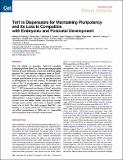| dc.contributor.author | Dawlaty, Meelad M. | |
| dc.contributor.author | Ganz, Kibibi | |
| dc.contributor.author | Powell, Benjamin E. | |
| dc.contributor.author | Hu, Yueh-Chiang | |
| dc.contributor.author | Markoulaki, Styliani | |
| dc.contributor.author | Cheng, Albert W. | |
| dc.contributor.author | Gao, Qing | |
| dc.contributor.author | Kim, Jongpil | |
| dc.contributor.author | Choi, Sang-Woon | |
| dc.contributor.author | Jaenisch, Rudolf | |
| dc.contributor.author | Page, David C | |
| dc.date.accessioned | 2014-12-30T18:28:14Z | |
| dc.date.available | 2014-12-30T18:28:14Z | |
| dc.date.issued | 2011-08 | |
| dc.date.submitted | 2011-06 | |
| dc.identifier.issn | 19345909 | |
| dc.identifier.uri | http://hdl.handle.net/1721.1/92553 | |
| dc.description.abstract | The Tet family of enzymes (Tet1/2/3) converts 5-methylcytosine (5mC) to 5-hydroxymethylcytosine (5hmC). Mouse embryonic stem cells (mESCs) highly express Tet1 and have an elevated level of 5hmC. Tet1 has been implicated in ESC maintenance and lineage specification in vitro but its precise function in development is not well defined. To establish the role of Tet1 in pluripotency and development, we have generated Tet1 mutant mESCs and mice. Tet1[superscript −/−] ESCs have reduced levels of 5hmC and subtle changes in global gene expression, and are pluripotent and support development of live-born mice in tetraploid complementation assay, but display skewed differentiation toward trophectoderm in vitro. Tet1 mutant mice are viable, fertile, and grossly normal, though some mutant mice have a slightly smaller body size at birth. Our data suggest that Tet1 loss leading to a partial reduction in 5hmC levels does not affect pluripotency in ESCs and is compatible with embryonic and postnatal development. | en_US |
| dc.description.sponsorship | Croucher Foundation (Croucher Scholarship) | en_US |
| dc.description.sponsorship | National Institutes of Health (U.S.) (Grant 5-RO1-HDO45022) | en_US |
| dc.description.sponsorship | National Institutes of Health (U.S.) (Grant 5-R37-CA084198) | en_US |
| dc.description.sponsorship | National Institutes of Health (U.S.). (Grant 5-RO1-CA087869) | en_US |
| dc.language.iso | en_US | |
| dc.publisher | Elsevier | en_US |
| dc.relation.isversionof | http://dx.doi.org/10.1016/j.stem.2011.07.010 | en_US |
| dc.rights | Article is made available in accordance with the publisher's policy and may be subject to US copyright law. Please refer to the publisher's site for terms of use. | en_US |
| dc.source | Elsevier | en_US |
| dc.title | Tet1 Is Dispensable for Maintaining Pluripotency and Its Loss Is Compatible with Embryonic and Postnatal Development | en_US |
| dc.type | Article | en_US |
| dc.identifier.citation | Dawlaty, Meelad M., Kibibi Ganz, Benjamin E. Powell, Yueh-Chiang Hu, Styliani Markoulaki, Albert W. Cheng, Qing Gao, et al. “Tet1 Is Dispensable for Maintaining Pluripotency and Its Loss Is Compatible with Embryonic and Postnatal Development.” Cell Stem Cell 9, no. 2 (August 2011): 166–175. © 2011 Elsevier Inc. | en_US |
| dc.contributor.department | Massachusetts Institute of Technology. Computational and Systems Biology Program | en_US |
| dc.contributor.department | Massachusetts Institute of Technology. Department of Biology | en_US |
| dc.contributor.department | Whitehead Institute for Biomedical Research | en_US |
| dc.contributor.mitauthor | Page, David C. | en_US |
| dc.contributor.mitauthor | Cheng, Albert W. | en_US |
| dc.contributor.mitauthor | Jaenisch, Rudolf | en_US |
| dc.relation.journal | Cell Stem Cell | en_US |
| dc.eprint.version | Final published version | en_US |
| dc.type.uri | http://purl.org/eprint/type/JournalArticle | en_US |
| eprint.status | http://purl.org/eprint/status/PeerReviewed | en_US |
| dspace.orderedauthors | Dawlaty, Meelad M.; Ganz, Kibibi; Powell, Benjamin E.; Hu, Yueh-Chiang; Markoulaki, Styliani; Cheng, Albert W.; Gao, Qing; Kim, Jongpil; Choi, Sang-Woon; Page, David C.; Jaenisch, Rudolf | en_US |
| dc.identifier.orcid | https://orcid.org/0000-0001-9920-3411 | |
| mit.license | PUBLISHER_POLICY | en_US |
| mit.metadata.status | Complete | |
